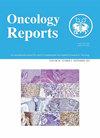S100A4 expression with reduced E-cadherin expression predicts distant metastasis of human malignant melanoma cell lines in the NOD/SCID/gammaCnull (NOG) mouse model.
IF 3.9
3区 医学
Q2 ONCOLOGY
引用次数: 27
Abstract
Tumor xenografts in immune-deficient mice (athymic nude mice and SCID mice) are well-established animal models for the study of human cancer. Several human melanoma cell lines were reported to metastasize in the immune-deficient mice models. However, metastatic rates were extremely low in spite of large numbers of injections of cancer cells, more than 1 x 10(6) cells/mouse. The NOD/SCID/gamma(C)(null) (NOG) mouse shows multiple immunological dysfunctions, including cytokine production capability, in addition to the functional incompetence of T, B and natural killer (NK) cells. However, the immune-deficient mice, with preserved NK cell activity, might interfere with engraftment efficiency. We examined the distant metastasis of the human melanoma cell lines (A2058, A375, G361 and HMY-1, 1 x 10(4) cells/mouse) in the 6 weeks after intravenous inoculation. All four melanoma cell lines showed metastasis in the NOG mice, while no metastatic lesions were observed in the NOD/SCID mice. Metastatic lesions were noted in the liver and lung of 6/6 (100%) mice at A2058, 8/9 (89%) at A375, 2/6 (33%) at G361 and 2/8 (25%) at HMY-1. A2058 and A375 cell lines with high metastatic potentials show increased gene expression of S100A4. Western blot assay confirmed the increased protein levels of S100A4 in the A2058 and A375 cell lines. E-cadherin gene expression was conversely inhibited in these cell lines. The increased expression of S100A4 combined with inhibited E-cadherin expression resulted in high metastatic potentials of the human melanoma cell lines in vivo.在NOD/SCID/gammaCnull (NOG)小鼠模型中,S100A4表达与E-cadherin表达降低可预测人类恶性黑色素瘤细胞系的远处转移。
免疫缺陷小鼠(胸腺裸小鼠和SCID小鼠)的肿瘤异种移植是研究人类癌症的良好动物模型。据报道,几种人类黑色素瘤细胞系在免疫缺陷小鼠模型中转移。然而,尽管大量注射癌细胞,转移率极低,超过1 × 10(6)个细胞/只小鼠。NOD/SCID/ γ (C)(null) (NOG)小鼠除了T、B和自然杀伤(NK)细胞功能不全外,还表现出多种免疫功能障碍,包括细胞因子产生能力。然而,保留NK细胞活性的免疫缺陷小鼠可能会干扰植入效率。我们在静脉接种后6周检测了人黑色素瘤细胞系(A2058、A375、G361和hmi -1, 1 × 10(4)个细胞/小鼠)的远处转移。所有4种黑色素瘤细胞系在NOG小鼠中均出现转移,而在NOD/SCID小鼠中未观察到转移病变。A2058组6/6(100%)、A375组8/9(89%)、G361组2/6(33%)和HMY-1组2/8(25%)小鼠的肝脏和肺部出现转移灶。高转移潜力的A2058和A375细胞系显示S100A4基因表达增加。Western blot检测证实A2058和A375细胞系中S100A4蛋白水平升高。e -钙粘蛋白基因表达在这些细胞系中被相反地抑制。S100A4表达的增加与E-cadherin表达的抑制导致人黑色素瘤细胞系在体内具有高转移潜力。
本文章由计算机程序翻译,如有差异,请以英文原文为准。
求助全文
约1分钟内获得全文
求助全文
来源期刊

Oncology reports
医学-肿瘤学
CiteScore
8.50
自引率
2.40%
发文量
187
审稿时长
3 months
期刊介绍:
Oncology Reports is a monthly, peer-reviewed journal devoted to the publication of high quality original studies and reviews concerning a broad and comprehensive view of fundamental and applied research in oncology, focusing on carcinogenesis, metastasis and epidemiology.
 求助内容:
求助内容: 应助结果提醒方式:
应助结果提醒方式:


